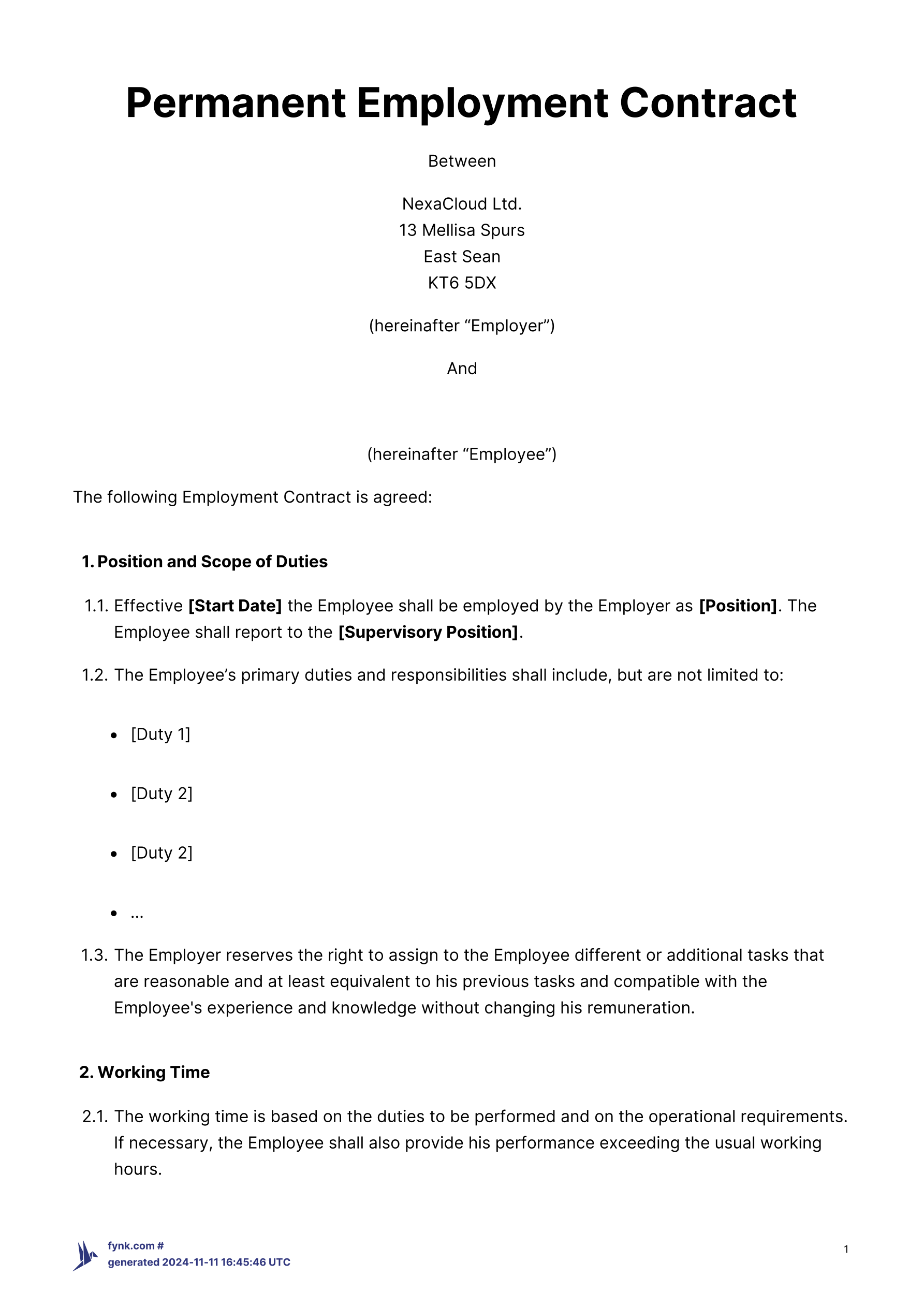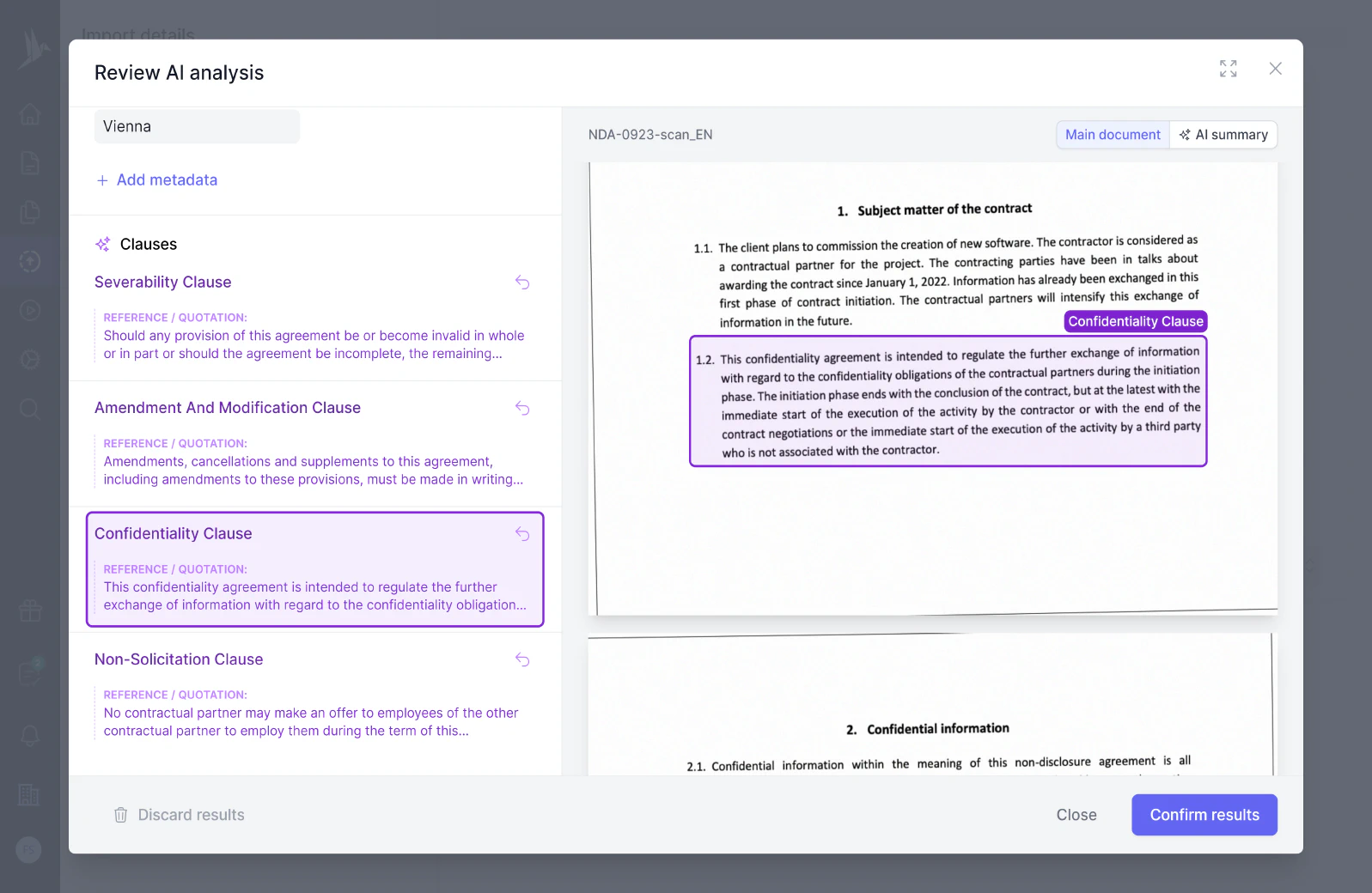
Employment Contract Template
An employment contract is a legally binding document that defines the working relationship between an employer and an employee.
The "Termination of Employment" clause outlines the conditions under which an employment contract can be terminated by either the employer or the employee. It typically includes details on notice periods, grounds for termination, severance pay, and any obligations or rights of both parties post-termination.
Your “termination of employment” (or similar terms) shall occur when you have incurred a “separation from service” within the meaning of Section 409A of the Code and as further defined herein. Specifically, you will have incurred a “separation from service” when the level of services you provide to the Company in any capacity, including as an employee, director, independent contractor or consultant, does not exceed 20% of the average level of services that you provided to the Company in the preceding 36 months (or shorter period of service if, for example, your total service with the Company is less than 36 months), all as determined in accordance with Section 409A of the Code. In determining whether a “separation from service” has occurred, any period of up to six months during which you are on a bona fide leave of absence or up to 29 months during which you are absent from work due to a disability for which you are receiving Marsh McLennan long-term disability benefits will be ignored.
Termination of Employment. (a)Any portion of the Stock Option that has not vested as of your Termination of Employment, other than as set forth under Sections 6, 7, 8 and 9 herein, will be immediately forfeited, and your rights with respect to such portion of the Stock Option will end. (b)You may exercise the portion of the Stock Option that has vested prior to your Termination of Employment by the earlier of (a) the Expiration Date, and (b) ninety (90) days from your Termination of Employment, subject to Sections 6, 7, 8 and 9 herein, as applicable.
Termination of Employment as a Result of a Divestiture or Outsourcing. If the business in which you are employed is being separated from the Company as a result of a Disposition of Assets, Disposition of a Subsidiary or an Outsourcing Agreement, and, as of the closing date of the applicable transaction you are designated in the transaction documents (either individually or by classification) as a “business employee” (or similar designation) who will be terminating employment with the Company and its Subsidiaries either because (i) you will remain with the separated business after the transaction or be transferred to the employment of the buyer or Outsourcing Agent as a result of the transaction; or (ii) you will not be offered continued employment by the Company or a Subsidiary, buyer or Outsourcing Agent after the close of the transaction, then your Stock Option Award will vest and become exercisable pro rata (standard rounding to the nearest Share in full-month increments) based on (a) the number of whole months that you have completed from the Grant Date through the end of the month of the closing date of the applicable transaction over the original number of months of the vesting period, times (b) the total number of Shares subject to the Stock Option on the Grant Date minus (c) the number of Shares previously vested pursuant to the Normal Vesting Terms. If you become entitled to the pro rata vesting described in this Section 9, you will not be entitled to any further vesting in your Stock Option Award, unless you are transferred to employment with the Company or a Subsidiary in a position outside of the business that is being separated from the Company (with the intent of continued employment with the Company or a Subsidiary outside of the separated business) prior to your Termination of Employment as a result of the Disposition of Assets, Disposition of a Subsidiary or an Outsourcing Agreement. The vested portion of your Stock Option Award will expire on the earlier of (x) the Expiration Date and (y) the third anniversary of your Termination of Employment.
General Termination Provisions. If Executive has a Termination of Employment during the Term, other than under the provisions of Section 6, then upon such Termination of Employment, Employer will be liable to Executive for all payments (if any) as described in this Section 5, as follows:
Termination of Employment. "Termination of Employment" means the ceasing of the Participant's employment from the AT&T controlled group of companies for any reason whatsoever, whether voluntarily or involuntarily. A Participant will be deemed to have realized a Termination of Employment at any time that a Participant and the Administrative Committee reasonably anticipate that the bona fide level of services the Participant will perform (whether as an employee or an independent contractor) will be permanently reduced to a level that is less than fifty percent (50%) of the average level of bona fide services the Participant performed during the immediately preceding thirty-six (36) months (or the entire period the Participant has provided services if the Participant has been providing services to the AT&T controlled group of companies less than thirty-six (36) months).
Definition of Termination of Employment. For purposes of this Agreement, the Executive's employment with the Company shall be deemed to be terminated when the Executive has a "Separation from Service" within the meaning of Section 409A of the Internal Revenue Code of 1986, as amended (the “Code”), and references to termination of employment shall be deemed to refer to a Separation from Service.
Termination of Employment for any Reason. The following payments will be made upon the Executive's termination of employment for any reason: (i) Earned but unpaid base salary through the date of termination; (ii) Any annual incentive plan bonus, for which the performance measurement period has ended, but which is unpaid at the time of termination; (iii) Any accrued but unpaid vacation; (iv) Any amounts payable under any of the Company's benefit plans in accordance with the terms of those plans, except as may be required under Code Section 401(a)(13); and (v) Unreimbursed business expenses incurred by the Executive on the Company's behalf.
Termination of Employment for Death or Disability. In addition to the amounts determined under (b) above, if the Executive's termination of employment occurs by reason of death or Disability (as defined below), the Executive (or the Executive's estate) will receive a pro rata portion of any bonus payable under the Company's annual incentive plan for the year in which such termination occurs determined based on the highest of (i) the actual annual bonus paid for the bonus plan year immediately preceding such termination, or (ii) the target bonus for the bonus plan year in which such termination occurs. For purposes of this Agreement, "Disability" shall mean, in the written opinion of a qualified physician selected by the Company, the Executive is by reason of any medically determinable physical or mental impairment that can be expected to result in death or can be expected to last for a continuous period of not less than twelve (12) months, (x) unable to engage in any substantial gainful activity, or (y) receiving income replacement benefits for a period of not less than three (3) months under a Company disability plan.
Termination of employment is one of the most important sections to include in a contract of employment which refers to the end of an individual’s employment with an employer. This can occur for various reasons, ranging from voluntary resignation to involuntary dismissal—and knowing the proper steps for how to terminate a contract with an employee can ensure legal compliance and fairness. It is a formal process that marks the concluding chapter of the employment relationship between an employer and employee. Termination can occur due to performance issues, layoffs, retirement, mutual agreement, or breach of contract.
Termination of employment should be considered in the following scenarios:
Writing a termination of employment involves clear communication and adherence to legal and company guidelines. Here’s a suggested structure:
Example:
[Company Name] [Company Address] [Date]
Dear [Employee Name],
This letter serves as formal notice that your employment with [Company Name] will be terminated effective [Date]. The reason for this termination is [Reason]. Please arrange to return all company property by [Date]. Should you have any inquiries, feel free to contact our HR department.
Sincerely,
[Your Name]
[Your Position]
Termination of employment clauses are commonly found in the following types of contracts:
These templates contain the clause you just read about.

An employment contract is a legally binding document that defines the working relationship between an employer and an employee.
Dive deeper into the world of clauses and learn more about these other clauses that are used in real contracts.
A termination of service agreement clause outlines the conditions under which either party may end the service contract, including any required notice periods and potential penalties or fees. It ensures that both parties understand their rights and obligations when discontinuing the agreement and helps prevent disputes.
A termination of trust agreement clause outlines the conditions under which a trust can be legally revoked or dissolved, detailing the responsibilities and duties of the trustee and beneficiaries during the termination process. It often specifies the distribution of the trust's assets and any necessary notifications or approvals required to execute the termination.
"Termination with cause" refers to a contract provision that allows one party to end the agreement if the other party engages in specific misconduct or breaches the contract's terms. This clause typically outlines what constitutes "cause," such as failure to meet obligations, illegal activity, or unethical behavior.
Try our AI contract analysis and extract important clauses and information from existing contracts.
< <
Fill out the form and we will get in touch with you to give you a personal, customized demo of fynk.
Greetings!
I'm Markus, co-founder of fynk. After you've submitted the form, I'll swiftly get in touch with you.
Also, right after you submit your details, you can pick a time that works best for you for our meeting.

